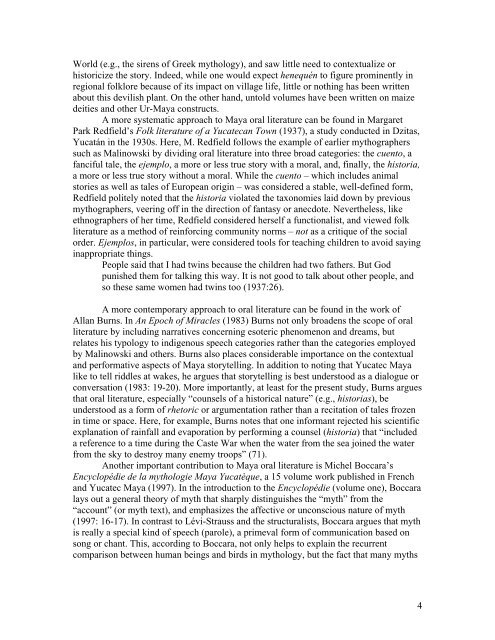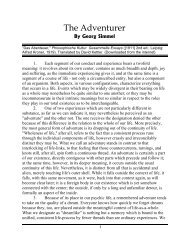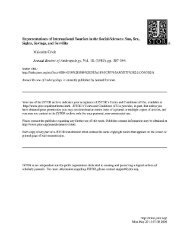The Maya Uay K'ot - OSEA-CITE
The Maya Uay K'ot - OSEA-CITE
The Maya Uay K'ot - OSEA-CITE
You also want an ePaper? Increase the reach of your titles
YUMPU automatically turns print PDFs into web optimized ePapers that Google loves.
World (e.g., the sirens of Greek mythology), and saw little need to contextualize or<br />
historicize the story. Indeed, while one would expect henequén to figure prominently in<br />
regional folklore because of its impact on village life, little or nothing has been written<br />
about this devilish plant. On the other hand, untold volumes have been written on maize<br />
deities and other Ur-<strong>Maya</strong> constructs.<br />
A more systematic approach to <strong>Maya</strong> oral literature can be found in Margaret<br />
Park Redfield’s Folk literature of a Yucatecan Town (1937), a study conducted in Dzitas,<br />
Yucatán in the 1930s. Here, M. Redfield follows the example of earlier mythographers<br />
such as Malinowski by dividing oral literature into three broad categories: the cuento, a<br />
fanciful tale, the ejemplo, a more or less true story with a moral, and, finally, the historia,<br />
a more or less true story without a moral. While the cuento – which includes animal<br />
stories as well as tales of European origin – was considered a stable, well-defined form,<br />
Redfield politely noted that the historia violated the taxonomies laid down by previous<br />
mythographers, veering off in the direction of fantasy or anecdote. Nevertheless, like<br />
ethnographers of her time, Redfield considered herself a functionalist, and viewed folk<br />
literature as a method of reinforcing community norms – not as a critique of the social<br />
order. Ejemplos, in particular, were considered tools for teaching children to avoid saying<br />
inappropriate things.<br />
People said that I had twins because the children had two fathers. But God<br />
punished them for talking this way. It is not good to talk about other people, and<br />
so these same women had twins too (1937:26).<br />
A more contemporary approach to oral literature can be found in the work of<br />
Allan Burns. In An Epoch of Miracles (1983) Burns not only broadens the scope of oral<br />
literature by including narratives concerning esoteric phenomenon and dreams, but<br />
relates his typology to indigenous speech categories rather than the categories employed<br />
by Malinowski and others. Burns also places considerable importance on the contextual<br />
and performative aspects of <strong>Maya</strong> storytelling. In addition to noting that Yucatec <strong>Maya</strong><br />
like to tell riddles at wakes, he argues that storytelling is best understood as a dialogue or<br />
conversation (1983: 19-20). More importantly, at least for the present study, Burns argues<br />
that oral literature, especially “counsels of a historical nature” (e.g., historias), be<br />
understood as a form of rhetoric or argumentation rather than a recitation of tales frozen<br />
in time or space. Here, for example, Burns notes that one informant rejected his scientific<br />
explanation of rainfall and evaporation by performing a counsel (historia) that “included<br />
a reference to a time during the Caste War when the water from the sea joined the water<br />
from the sky to destroy many enemy troops” (71).<br />
Another important contribution to <strong>Maya</strong> oral literature is Michel Boccara’s<br />
Encyclopédie de la mythologie <strong>Maya</strong> Yucatèque, a 15 volume work published in French<br />
and Yucatec <strong>Maya</strong> (1997). In the introduction to the Encyclopédie (volume one), Boccara<br />
lays out a general theory of myth that sharply distinguishes the “myth” from the<br />
“account” (or myth text), and emphasizes the affective or unconscious nature of myth<br />
(1997: 16-17). In contrast to Lévi-Strauss and the structuralists, Boccara argues that myth<br />
is really a special kind of speech (parole), a primeval form of communication based on<br />
song or chant. This, according to Boccara, not only helps to explain the recurrent<br />
comparison between human beings and birds in mythology, but the fact that many myths<br />
4




